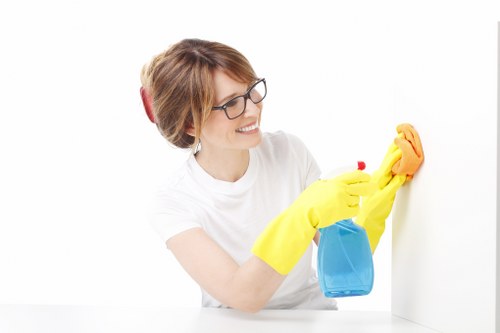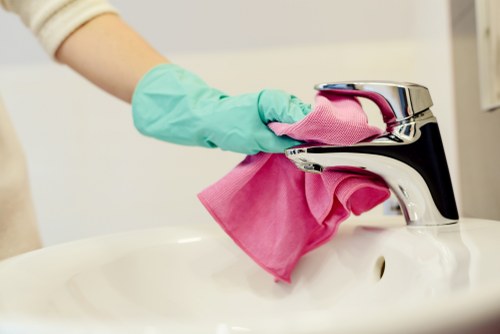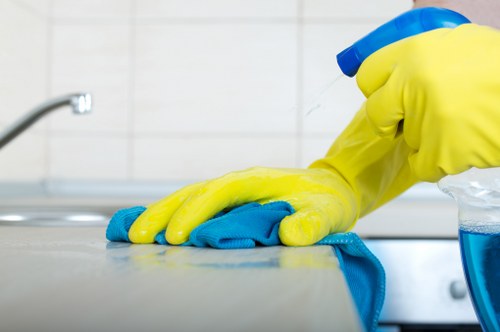Upholstery Cleaning in House Cleaning: A Comprehensive Guide

Maintaining a clean and healthy home environment goes beyond regular sweeping and mopping. One essential aspect of comprehensive house cleaning is upholstery cleaning. Upholstered furniture, including sofas, chairs, and cushions, can harbor dust, allergens, and stains that not only diminish the appearance of your home but also impact indoor air quality.
Upholstery cleaning is a specialized process that requires the right techniques and products to effectively remove dirt and restore the fabric's original beauty. Whether you have a busy household with children and pets or you're aiming to prolong the life of your furniture, understanding the importance and methods of upholstery cleaning is crucial.
In this guide, we'll delve into the various aspects of upholstery cleaning, offering tips and insights to help you maintain spotless and fresh-looking furniture. From identifying the type of fabric to choosing the right cleaning method, we'll cover everything you need to know to keep your upholstered pieces in pristine condition.

The Importance of Upholstery Cleaning
Upholstery cleaning plays a vital role in maintaining the aesthetics and hygiene of your home. Over time, furniture accumulates dust, sweat, spills, and other contaminants that can lead to unpleasant odors and potential allergens.
Regular cleaning extends the lifespan of your upholstery by preventing the buildup of stains and wear. It also enhances the overall appearance of your living spaces, making them more inviting and comfortable.
Moreover, a clean upholstered environment contributes to better indoor air quality, reducing the risk of respiratory issues and allergies, especially for sensitive individuals.

Types of Upholstery Fabrics
Understanding the type of fabric your furniture is made of is essential for effective cleaning. Different fabrics require specific cleaning methods to avoid damage and ensure optimal results.
Natural Fabrics
Natural fabrics like cotton, linen, wool, and silk are popular choices for upholstery due to their comfort and breathability. These materials are generally more delicate and require gentle cleaning techniques.
Cleaning Tips for Natural Fabrics
- Use mild detergents or specialized fabric cleaners.
- Avoid excessive water to prevent shrinking or warping.
- Test any cleaning solution on a small, inconspicuous area first.
Synthetic Fabrics
Synthetic fabrics such as polyester, nylon, and microfiber are known for their durability and resistance to stains. They are easier to clean and maintain compared to natural fibers.
Cleaning Tips for Synthetic Fabrics
- Utilize water-based or solvent-based cleaners depending on the stain type.
- Microfiber can often be cleaned with a simple vacuum or damp cloth.
- Always follow the manufacturer’s care instructions.

Common Upholstery Cleaning Methods
Choosing the right cleaning method depends on the fabric type, the nature of the stains, and the overall condition of the upholstery. Here are some of the most effective techniques:
Steam Cleaning
Steam cleaning is a popular method that uses high-temperature steam to penetrate deep into the fabric, effectively killing bacteria and removing dirt. It's suitable for most fabric types but should be used cautiously on delicate materials.
Dry Cleaning
Dry cleaning involves the use of chemical solvents instead of water. This method is ideal for fabrics that are sensitive to moisture and helps in removing oily stains without causing shrinkage.
Foam Cleaning
Foam cleaning applies a foam-based solution to the upholstery, which loosens dirt and stains. After a brief dwell time, the foam is vacuumed away, taking the contaminants with it. This method is efficient for quick cleaning and dries faster than steam cleaning.
Encapsulation Cleaning
Encapsulation cleaning uses a polymer solution that encapsulates dirt particles, making them easy to remove with vacuuming. It's an eco-friendly option that leaves no residue and is safe for children and pets.

DIY Upholstery Cleaning Tips
While professional upholstery cleaning services offer thoroughness and expertise, there are several effective DIY upholstery cleaning methods you can implement to maintain your furniture between professional cleanings.
Regular Vacuuming
Vacuuming your upholstery regularly helps in removing surface dust and debris. Use the appropriate attachments to reach crevices and hard-to-clean areas.
Spot Cleaning
Addressing spills and stains immediately prevents them from setting into the fabric. Use a clean cloth and a suitable cleaning solution to dab the affected area gently.
Homemade Cleaning Solutions
- Mix equal parts of white vinegar and water for a natural cleaning agent.
- Add a few drops of dish soap to the solution for enhanced cleaning power.
- Apply the solution to the stain using a spray bottle and blot with a clean cloth.
Baking Soda Treatment
Sprinkling baking soda over your upholstery can help in absorbing odors and moisture. Let it sit for 15-20 minutes before vacuuming it off.
Protective Measures
Using fabric protectors can guard your upholstery against future stains and spills. Additionally, arranging furniture away from direct sunlight prevents fading and fabric degradation.
When to Hire Professional Upholstery Cleaners
While DIY methods are effective for routine maintenance, certain situations warrant the expertise of professional upholstery cleaners:
- Deep-seated stains and stubborn blemishes that persist despite household cleaning efforts.
- Heavy soiling from pets, smoke, or high-traffic areas.
- Delicate or antique fabrics that require specialized care to prevent damage.
- Regular maintenance for optimal indoor air quality and hygiene.
Professional cleaners have the right tools, cleaning agents, and knowledge to handle a wide range of fabrics and stains, ensuring your upholstery looks and feels its best.
Choosing the Right Professional Service
When selecting an upholstery cleaning service, consider the following factors:
- Experience and expertise in handling different fabric types.
- Use of eco-friendly and non-toxic cleaning agents.
- Transparent pricing and service guarantees.
- Positive customer reviews and testimonials.
The Benefits of Regular Upholstery Cleaning
Incorporating upholstery cleaning into your regular house cleaning routine offers numerous benefits:
- Enhanced Appearance: Clean upholstery instantly boosts the look of your living spaces.
- Healthier Environment: Removing allergens and bacteria contributes to better respiratory health.
- Extended Furniture Lifespan: Regular maintenance prevents wear and tear, saving you money in the long run.
- Improved Comfort: Fresh and clean furniture provides a more comfortable and inviting atmosphere.
Eco-Friendly Cleaning Practices
Adopting environmentally friendly upholstery cleaning practices not only protects your health but also benefits the planet. Opt for biodegradable cleaning agents and methods that conserve water and reduce chemical usage.
Green Cleaning Tips
- Use natural ingredients like vinegar, baking soda, and lemon juice for effective cleaning.
- Choose steam cleaning methods that minimize the need for harsh chemicals.
- Ensure proper ventilation when using any cleaning products to maintain indoor air quality.
Maintaining Upholstery Between Cleanings
To keep your upholstery in top condition between professional cleanings, follow these maintenance tips:
Regular Vacuuming
Vacuum your furniture weekly to remove dust and prevent dirt from embedding into the fabric.
Immediate Spill Response
Attend to spills promptly by blotting (not rubbing) the area with a clean, dry cloth to absorb as much liquid as possible.
Rotate Cushions
Periodically rotating and flipping cushions ensures even wear and maintains the shape of your furniture.
Use Protective Covers
Protective covers and slipcovers can shield your upholstery from daily wear and accidental spills, making it easier to clean and maintain.
Choosing the Right Cleaning Products
Selecting appropriate cleaning products is crucial for effective upholstery cleaning without causing damage. Here are some guidelines:
Identify Stain Types
Different stains require different treatments. Common stains include:
- Water-Based Stains: Such as coffee, tea, and juice can be treated with water-based cleaners.
- Oil-Based Stains: Including grease and makeup require solvent-based cleaners.
- Protein-Based Stains: Such as blood and sweat should be treated with enzymatic cleaners.
Check Fabric Care Labels
Always refer to the manufacturer's care instructions before applying any cleaning product to avoid damaging the fabric.
Test Cleaning Solutions
Before applying a new cleaning solution, test it on a small, hidden area of the upholstery to ensure it doesn't cause discoloration or damage.
Recommended Cleaning Agents
- White Vinegar: A natural disinfectant and deodorizer.
- Baking Soda: Effective for absorbing odors and gentle on fabrics.
- Dish Soap: Suitable for removing grease and oil-based stains.
- Alcohol-Based Cleaners: Good for quick-drying and spot cleaning.
Common Upholstery Stains and How to Remove Them
Different types of stains require specific cleaning approaches to ensure effective removal without damaging the fabric.
Coffee and Tea Stains
Blot the spill immediately with a clean cloth. Mix a solution of equal parts white vinegar and water, apply to the stain, and blot until the stain lifts. Rinse with a damp cloth and allow to dry.
Red Wine Stains
Blot the excess wine, sprinkle baking soda over the area, let it sit for 15 minutes, then vacuum. Apply a mixture of hydrogen peroxide and dish soap, scrub gently, and rinse with cold water.
Grease and Oil Stains
Sprinkle cornstarch or baking soda on the stain to absorb excess oil. Let it sit for 30 minutes, then vacuum. Apply a solvent-based cleaner, blot with a clean cloth, and allow to dry.
Ink Stains
Place a paper towel under the stained area, apply rubbing alcohol with a cotton ball, and dab until the ink transfers to the cotton. Rinse with water and blot dry.
Pet Stains
Remove solid waste first, then blot the area with a mixture of water and white vinegar. Apply an enzymatic cleaner to break down organic matter and eliminate odors.
Preventative Measures for Upholstery Care
Implementing preventative measures can significantly reduce the need for frequent deep cleanings and prolong the life of your upholstery.
Use Throws and Covers
Protect your furniture by using throws, blankets, or slipcovers. These can be easily washed and replaced, minimizing direct contact with the upholstery.
Avoid Direct Sunlight
Exposing upholstery to direct sunlight can cause fading and weaken fabric fibers over time. Use curtains or blinds to regulate sunlight exposure.
No Eating on Upholstered Furniture
Limiting eating on sofas and chairs reduces the risk of spills and food-related stains.
Rotate Furniture Placement
Changing the position of your furniture periodically prevents uneven wear and tear on high-traffic areas.
Conclusion
Incorporating upholstery cleaning into your regular house cleaning routine is essential for maintaining a beautiful and healthy home. By understanding the different fabric types, utilizing appropriate cleaning methods, and implementing preventative measures, you can ensure your upholstered furniture remains pristine and long-lasting.
Whether you choose to perform DIY cleaning or hire professional services, the key is consistency and care. Regular maintenance not only enhances the aesthetic appeal of your home but also contributes to a healthier living environment for you and your family.
Don't wait for stains to set or allergens to accumulate. Contact us today to learn more about professional upholstery cleaning services or book your service now to give your furniture the care it deserves.